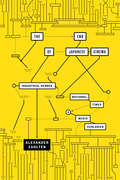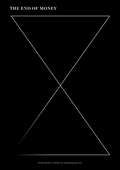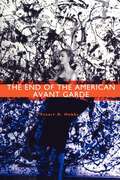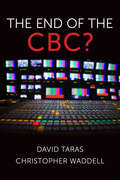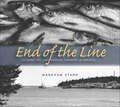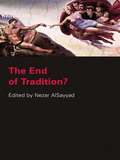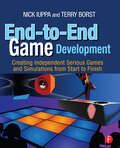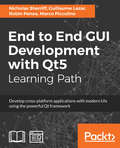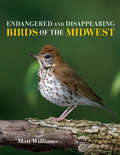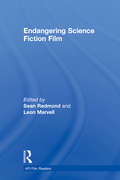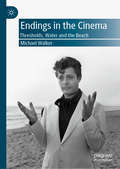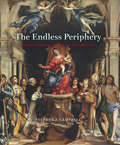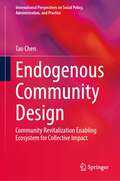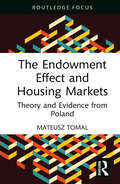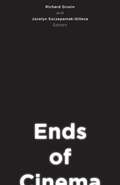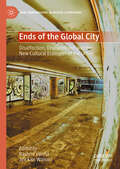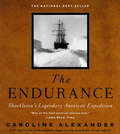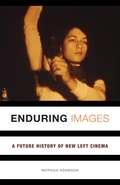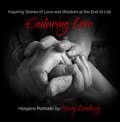- Table View
- List View
The End of Genre: Curations and Experiments in Intentional Discourses (Postdisciplinary Studies in Discourse)
by Brenton FaberThis book explores early new critical debates about intention, tracing how and why intention was dismissed across much humanities scholarship, and how it can be revisited and made relevant as a key formative, evaluative, and ethical concept. The author argues that the academic disinterest in intention occurred simultaneously as genre criticism and later the rhetorical interest in genre came into its own. Genre became a way to simultaneously elide and naturalize intention. The book elaborates on the pedagogical, ethical, and empirical consequences naturalizing intention through genre has had for rhetorical studies and it offers a new term, “curations” to identify discursive forms, actions, and intentions working simultaneously. Finally, he also examines the gap between the humanities and STEM fields and shows specific ways scientists and engineers have called for the humanities to become more invested in intention as both a critical and an operational concept. This book will be of interest to students and scholars of discourse studies and critical discourse analysis, rhetoric and professional communication, including those in fields such as medicine, engineering, STS and business studies.
The End of Japanese Cinema: Industrial Genres, National Times, and Media Ecologies
by Alexander ZahltenIn The End of Japanese Cinema Alexander Zahlten moves film theory beyond the confines of film itself, attending to the emergence of new kinds of aesthetics, politics, temporalities, and understandings of film and media. He traces the evolution of a new media ecology through deep historical analyses of the Japanese film industry from the 1960s to the 2000s. Zahlten focuses on three popular industrial genres: Pink Film (independently distributed softcore pornographic films), Kadokawa (big-budget productions as part of a transmedia strategy), and V-Cinema (direct-to-video films). He examines the conditions of these films' production to demonstrate how the media industry itself becomes part of the politics of the media text and to highlight the complex negotiation between media and politics, culture, and identity in Japan. Zahlten points to a different history of film, one in which a once-powerful film industry transformed into becoming only one component within a complex media-mix ecology. In so doing, Zahlten opens new paths for uncovering similar broad processes in other large media societies. A Study of the Weatherhead East Asian Institute, Columbia University
The End of Money
by Juan A. GaitánThis book has been conceived as a parallel reflection to the exhibition The End of Money . It includes a number of contributions that extend the exhibition proper beyond its self-contained existence in the gallery space. In this respect, it is also a vehicle through which the exhibition can find different discursive grounds for exploring the theme of the end of money, both as a literary and as an iconographic motif.
The End Of Money
by David Weiss Dieter Roelstraete Peter Fischli Donatien Grau Dessislava DimovaThis digital publication (with a limited print edition of 100) accompanies the exhibition The End of Money (22 May - 7 August 2011).
The End of Money
by David WolmanFor ages, money has meant little metal disks and rectangular slips of paper. Yet the usefulness of physical money--to say nothing of its value--is coming under fire as never before. Intrigued by the distinct possibility that cash will soon disappear, author and Wired contributing editor David Wolman sets out to investigate the future of money. . . and how it will affect your wallet. Wolman begins his journey by deciding to shun cash for an entire year--a surprisingly successful experiment (with a couple of notable exceptions). He then ventures forth to find people and technologies that illuminate the road ahead. In Honolulu, he drinks Mai Tais with Bernard von NotHaus, a convicted counterfeiter and alternative-currency evangelist whom government prosecutors have labeled a domestic terrorist. In Tokyo, he sneaks a peek at the latest anti-counterfeiting wizardry, while puzzling over the fact that banknote forgers depend on society's addiction to cash. In a downtrodden Oregon town, he mingles with obsessive coin collectors--the people who are supposed to love cash the most, yet don't. And in rural Georgia, he examines why some people feel the end of cash is Armageddon's warm-up act. After stops at the Digital Money Forum in London and Iceland's central bank, Wolman flies to Delhi, where he sees first-hand how cash penalizes the poor more than anyone--and how mobile technologies promise to change that. Told with verve and wit, The End of Money explores an aspect of our daily lives so fundamental that we rarely stop to think about it. You'll never look at a dollar bill the same again.
The End of the American Avant Garde: American Social Experience Series (The\american Social Experience Ser.)
by Stuart D. Hobbs"By 1966, the composer Virgil Thomson would write, "Truth is, there is no avant-garde today." How did the avant garde dissolve, and why? In this thought-provoking work, Stuart D. Hobbs traces the avant garde from its origins to its eventual appropriation by a conservative political agenda, consumer culture, and the institutional world of art.
The End of the CBC?
by David Taras Christopher WaddellThe End of the CBC? is about three overlapping crises: the crisis that has enveloped the CBC, the crisis of news, and the crisis of democracy. They are all the result to some degree of the vast changes that have overtaken and consumed the media world in the last ten to fifteen years. The emergence of platforms such as Google, Facebook, Twitter, and Netflix, the hyper-targeting of individual users through data analytics, the development of narrow online identity communities, and the rise of an attention economy that makes it more and more difficult for any but the most powerful media organizations to be noticed, have changed the media landscape in dramatic ways. The effects on the CBC and on other Canadian media organizations have been shattering. Describing the failure of successive governments to address problems faced by the public broadcaster, this book explains how the CBC lost its place in sports, drama, and entertainment. Taras and Waddell propose a way forward for the CBC – one in which the corporation concentrates its resources on news and current affairs and re-establishes a reputation for depth and quality.
End of the Line: Closing the Last Sardine Cannery in America (The Driftless Connecticut Series)
by Markham StarrAt one time, sardines were an inexpensive staple for many Americans. The 212 photographs in this elegant volume offer a striking document of this now vanished industry. Generations of workers in Maine have snipped, sliced, and packed the small, silvery fish into billions of cans on their way to Americans' lunch buckets and kitchen cabinets. On April 15, 2010, Stinson's Seafood, once the home of Beach Cliff Sardines, shut down the packing line that had made the name world famous. Begun in 1927, Stinson's empire eventually included sardine canneries spread along the Maine coast and a fleet of ships to supply them. With this closing, however, the end of the entire sardine industry in Maine had finally arrived. Photographer Markham Starr was privileged to spend several days at the Stinson factory in Prospect Harbor, one month before it was dismantled, emerging with a collection of remarkable images that transform the parts of the cannery into works of art and capture the resilience of the workers faced with the loss of jobs many had held for decades. This book includes a short essay, and shows the heartland of Maine at its finest.
The End of the Village: Planning the Urbanization of Rural China (Globalization and Community #33)
by Nick R. SmithHow China&’s expansive new era of urbanization threatens to undermine the foundations of rural life Since the beginning of the twenty-first century, China has vastly expanded its urbanization processes in an effort to reduce the inequalities between urban and rural areas. Centered on the mountainous region of Chongqing, which serves as an experimental site for the country&’s new urban development policies, The End of the Village analyzes the radical expansion of urbanization and its consequences for China&’s villagers. It reveals a fundamental rewriting of the nation&’s social contract, as villages that once organized rural life and guaranteed rural livelihoods are replaced by an increasingly urbanized landscape dominated by state institutions. Throughout this comprehensive study of China&’s &“urban–rural coordination&” policy, Nick R. Smith traces the diminishing autonomy of the country&’s rural populations and their subordination to larger urban networks and shared administrative structures. Outside Chongqing&’s urban centers, competing forces are at work in reshaping the social, political, and spatial organization of its villages. While municipal planners and policy makers seek to extend state power structures beyond the boundaries of the city, village leaders and inhabitants try to maintain control over their communities&’ uncertain futures through strategies such as collectivization, shareholding, real estate development, and migration.As China seeks to rectify the development crises of previous decades through rapid urban growth, such drastic transformations threaten to displace existing ways of life for more than 600 million residents. Offering an unprecedented look at the country&’s contentious shift in urban planning and policy, The End of the Village exposes the precarious future of rural life in China and suggests a critical reappraisal of how we think about urbanization.
The End of Tradition?
by Nezar AlSayyadRooted in real world observations, this book questions the concept of tradition - whether contemporary globalization will prove its demise or whether there is a process of simultaneous ending and renewing. In his introduction, Nezar Alsayyad discusses the meaning of the word 'tradition' and the current debates about the 'end of tradition'. Thereafter the book is divided into three parts. The three chapters in part I explore the inextricable link between 'tradition' and 'modern', revealing the geopolitical implications of this link. Part II looks at tradition as a process of invention and here the three chapters are all concerned with the making of landscapes and landscape myths, showing how the spectacle of history can be aestheticized and naturalized. Finally, Part III shows how traditionis a regime, programmed and policed and how it has been deployed, resisted, and reworked through hegemonic struggles that seek to create both built environments and citizen-subjects.
End-to-End Game Development: Creating Independent Serious Games and Simulations from Start to Finish
by Nick Iuppa Terry BorstYou're part of a new venture, an independent gaming company, and you are about to undertake your first development project. The client wants a serious game, one with instructional goals and assessment metrics. Or you may be in a position to green light such a project yourself, believing that it can advance your organization's mission and goals. This book provides a proven process to take an independent game project from start to finish. In order to build a successful game, you need to wear many hats. There are graphic artists, software engineers, designers, producers, marketers - all take part in the process at various (coordinated) stages, and the end result is hopefully a successful game. Veteran game producers and writers (Iuppa and Borst) cover all of these areas for you, with step by step instructions and checklists to get the work done.The final section of the book offers a series of case studies from REAL indy games that have been developed and launched succesfully, and show exactly how the principles outlined in the book can be applied to real world products. The book's associated author web site offers ancillary materials & references as well as serious game demos and presentations.
End to End GUI Development with Qt5: Develop cross-platform applications with modern UIs using the powerful Qt framework
by Nicholas Sherriff Guillaume Lazar Robin Penea Marco PiccolinoLearn the complete Qt ecosystem and its tools and build UIs for mobile and desktop applicationsKey FeaturesUnleash the power of the latest Qt 5.9 with C++14Easily compile, run, and debug your applications from the powerful Qt Creator IDEBuild multi-platform projects that target Android, iOS, Windows, MacOS, Linux, and moreBook DescriptionQt 5.9 is an application development framework that provides a great user experience and develops full-capability applications with Qt Widgets, QML, and even Qt 3D. This learning path demonstrates the power and flexibility of the Qt framework for desktop application development and shows how you can write an application once and deploy it to multiple operating systems. It will address all the challenges while developing cross-platform applications with the Qt framework.This course will give you a better understanding of the Qt framework and tools to resolve serious issues such as linking, debugging, and multithreading. It will also upskill you by explaining how to create a to-do-style app and taking you through all the stages in building a successful project. You will build a suite of apps; while developing these apps, you’ll deepen your knowledge of Qt Quick's layout systems, and see Qt 3D and widgets in action. The next project will be in the industrial and agricultural sectors: making sense of sensor data via a monitoring system. Your apps should run seamlessly across devices and operating systems such as Android, iOS, Windows, or Mac, and be cost-effective by integrating with existing web technologies. You take the role of lead developer and prototype a monitoring system. In doing so, you’ll get to know Qt's Bluetooth and HTTP APIs, as well as the Charts and Web Engine UI modules. These projects will help you gain a holistic view of the Qt framework.What you will learnInstall and configure the Qt Framework and Qt Creator IDEImplement a rich user interface with QMLLearn the fundamentals of QtTest and how to integrate unit testingCreate stunning UIs with Qt Widget and Qt QuickDevelop powerful, cross-platform applications with the Qt frameworkDesign GUIs with Qt Designer and build a library in it for UI previewsBuild a desktop UI with widgets and DesignerGet familiar with multimedia components to handle visual input and outputWho this book is forThis book will appeal to developers and programmers who would like to build GUI-based applications. Knowledge of C++ is necessary and a basic familiarity with Qt would be helpful.
Endangered and Disappearing Birds of the Midwest
by Matt WilliamsThis bird-lover&’s guide to spotting the endangered birds of the Midwest features fascinating information, helpful maps, and stunning color photography.Birds captivate us with their lively behavior and colorful beauty. They also enhance our environments in many ways, from controlling pest populations to pollinating crops. Yet, sadly, many species of birds across Minnesota, Wisconsin, Illinois, Iowa, Indiana, Michigan, and Ohio are in danger of extinction due to loss of habitat, agricultural expansion, changing forest conditions, and encounters with humans.In Endangered and Disappearing Birds of the Midwest, conservationist and endangered species expert Matt Williams profiles forty of the most beautiful and fascinating birds who winter, breed, or migrate through the Midwest and whose populations are most in danger of disappearing from the region. Each profile includes the current endangered status of the species, a description of the bird's vocal and nesting patterns, and tips to help readers identify them, along with stunning color images and detailed migration maps. An exquisite and timely examination of our feathered friends, Endangered and Disappearing Birds of the Midwest is a call to action to protect these vulnerable and gorgeous creatures that enliven our world.
Endangering Science Fiction Film (AFI Film Readers)
by Sean Redmond Leon MarvellEndangering Science Fiction Film explores the ways in which science fiction film is a dangerous and endangering genre. The collection argues that science fiction's cinematic power rests in its ability to imagine ‘Other’ worlds that challenge and disturb the lived conditions of the ‘real’ world, as it is presently known to us. From classic films such as 2001: A Space Odyssey and Solaris to modern blockbusters including World War Z and Gravity, and directors from David Cronenberg to Alfonso Cuarón, contributors comment on the way science fiction film engages with dangerous encounters, liminal experiences, sublime aesthetics, and untethers space and time to question the very nature of human existence. With the analysis of a diverse range of films from Europe, Asia, North and South America, Endangering Science Fiction Film offers a uniquely interdisciplinary view of the evolving and dangerous sentiments and sensibility of this genre.
The Endings: Photographic Stories of Love, Loss, Heartbreak, and Beginning Again
by Caitlin Cronenberg Jessica EnnisFeaturing some of today's most beloved actors, these piercing photographic vignettes capture female characters in the throes of powerful emotional transformations. Photographer Caitlin Cronenberg and art director Jessica Ennis collected stories of heartbreak, relationship endings, and new beginnings—fictional but often inspired by real life—and set out to convey the raw emotions that are exposed in those most vulnerable of states. Collaborating with celebrated talents such as Julianne Moore, Keira Knightley, and Gugu Mbatha-Raw, Cronenberg and Ennis developed each character, built her world, and then photographed as she lived the role before the camera. The resulting collection is a bold look at the experience of losing or leaving love and will speak to anyone who appreciates art, photography, and the strength of facing emotional depths head-on.
Endings in the Cinema: Thresholds, Water and the Beach
by Michael WalkerThis book offers a new way of thinking about film endings. Whereas existing works on the subject concentrate on narrative resolution, this book explores the way film endings blend together a complex of motifs, tropes and other elements to create the sense of an ending—that is, it looks at ‘endings as endings’. Drawing on a wide range of examples taken from films of different periods and national cinemas, the author identifies three key features which structure the work: thresholds and boundaries, water, and, above all, the beach. The beach combines water and a boundary and is the most resonant of the key sites to which film endings gravitate. Although beach endings go back to at least 1910, they have increased markedly in post-classical cinema, and can be found across all genres and in films from many different countries. As the leading example of the book’s argument, they illustrate both the aesthetic richness and the structural complexity of film endings.
Endless Intervals: Cinema, Psychology, and Semiotechnics around 1900
by Jeffrey West KirkwoodRevealing cinema&’s place in the coevolution of media technology and the humanCinema did not die with the digital, it gave rise to it. According to Jeffrey West Kirkwood, the notion that digital technologies replaced analog obscures how the earliest cinema laid the technological and philosophical groundwork for the digital world. In Endless Intervals, he introduces a theory of semiotechnics that explains how discrete intervals of machines came to represent something like a mind—and why they were feared for their challenge to the uniqueness of human intelligence.Examining histories of early cinematic machines, Kirkwood locates the foundations for a scientific vision of the psyche as well as the information age. He theorizes an epochal shift in the understanding of mechanical stops, breaks, and pauses that demonstrates how cinema engineered an entirely new model of the psyche—a model that was at once mechanical and semiotic, discrete and continuous, physiological and psychological, analog and digital.Recovering largely forgotten and untranslated texts, Endless Intervals makes the case that cinema, rather than being a technology assaulting the psyche, is in fact the technology that produced the modern psyche. Kirkwood considers the ways machines can create meaning, offering a fascinating theory of how the discontinuous intervals of soulless mechanisms ultimately produced a rich continuous experience of inner life.
The Endless Periphery: Toward a Geopolitics of Art in Lorenzo Lotto's Italy (Louise Smith Bross Lecture Series)
by Stephen J. CampbellWhile the masterpieces of the Italian Renaissance are usually associated with Italy’s historical seats of power, some of the era’s most characteristic works are to be found in places other than Florence, Rome, and Venice. They are the product of the diversity of regions and cultures that makes up the country. In Endless Periphery, Stephen J. Campbell examines a range of iconic works in order to unlock a rich series of local references in Renaissance art that include regional rulers, patron saints, and miracles, demonstrating, for example, that the works of Titian spoke to beholders differently in Naples, Brescia, or Milan than in his native Venice. More than a series of regional microhistories, Endless Periphery tracks the geographic mobility of Italian Renaissance art and artists, revealing a series of exchanges between artists and their patrons, as well as the power dynamics that fueled these exchanges. A counter history of one of the greatest epochs of art production, this richly illustrated book will bring new insight to our understanding of classic works of Italian art.
Endogenous Community Design: Community Revitalization Enabling Ecosystem for Collective Impact (International Perspectives on Social Policy, Administration, and Practice)
by Tao ChenThis book is a comprehensive exploration of endogenous community building, aiming to investigate how to create a vibrant, service-integrated, and sustainable community through collective impact approaches. It’s a guide to social innovation that combines theory and practical application. In terms of theory, it constructs concepts such as endogenous community, endogenous design system, life project platform and enabling ecosystem. In practice, it offers design methods and a toolkit for collective impact to enhance community resilience and capacity through service co-creation. This book provides readers with a systematic guide to endogenous community design, ranging from conceptual understanding and theoretical models to practical methodologies. Its aim is to build a sociotechnical system from the bottom-up to address complex issues.This book is ideal for community leaders, government officials, NGOs, urban planners, social innovators, and anyone passionate about sustainable community development.
The Endowment Effect and Housing Markets: Theory and Evidence from Poland (Routledge Studies in International Real Estate)
by Mateusz TomalThis book aims to provide a comprehensive analysis of the so-called “endowment effect” in the housing market. In a nutshell, the phenomenon of overvaluing things we own which was first conceptualised in 1980 and has since been one of the most studied behavioural biases in economics.The first chapter presents a systematic review of the literature on the endowment effect in the housing market, together with the identification of research gaps to be filled by other researchers. The second chapter aims to propose a theoretical model explaining the strength of the endowment effect in sales and rental housing markets by primary and secondary markets. The last chapter presents the results of empirical research on the endowment effect in the Polish housing market, testing the model presented in Chapter 2. The chapters can be read together or independently by researchers, students, and policymakers interested in behavioural economics in housing and real estate. For policymakers, the book can be extremely useful as the endowment effect can create friction in the housing market because of a mismatch between the price demands of sellers and buyers, especially in countries where the level of market professionalisation is low (such as Poland). Thanks to the empirical research contained in this book, it will be possible to identify specific market segments where the endowment effect may be particularly elevated – on such segments, policymakers should introduce actions contributing to the elimination of this behavioural bias.
Ends of Cinema (21st Century Studies)
by Richard Grusin Jocelyn Szczepaniak-GilleceAt the dawn of the digital era in the final decades of the twentieth century, film and media studies scholars grappled with the prospective end of what was deemed cinema: analog celluloid production, darkened public movie theaters, festival culture. The notion of the &“end of cinema&” had already been broached repeatedly over the course of the twentieth century—from the introduction of sound and color to the advent of television and video—and in Ends of Cinema, contributors reinvigorate this debate to contemplate the ends, as well as directions and new beginnings, of cinema in the twenty-first century.In this volume, scholars at the forefront of film and media studies interrogate multiple potential &“ends&” of cinema: its goals and spaces, its relationship to postcinema, its racial dynamics and environmental implications, and its theoretical and historical conclusions. Moving beyond the predictable question of digital versus analog, the scholars gathered here rely on critical theory and historical research to consider cinema alongside its media companions: television, the gallery space, digital media, and theatrical environments. Ends of Cinema underscores the shared project of film and media studies to open up what seems closed off, and to continually reinvent approaches that seem unresponsive. Contributors: Caetlin Benson-Allott, Georgetown U; James Leo Cahill, U of Toronto; Francesco Casetti, Yale U; Mary Ann Doane, U of California Berkeley; André Gaudreault, U de Montréal; Michael Boyce Gillespie, City College of New York; Mark Paul Meyer, EYE Filmmuseum; Jennifer Lynn Peterson, Woodbury U, Los Angeles; Amy Villarejo, Cornell U.
Ends of the Global City: Disaffection, Displacement and the New Cultural Ecologies of the Urban (New Comparisons in World Literature)
by Rashmi Varma Jini Kim WatsonThis volume of essays explores how the global city is confronting new forms of crises and disruption. Examining cities in the Caribbean, North America, Africa, the Persian Gulf, Asia and Australia, the essays use literary and cultural analysis to examine the pasts, present and futures of the global city. Ranging from the period of high postcolonial development, industrialization and compacted modernization to present-day neoliberal urban planning, the collection considers arrivals and departures in the global city, offering new critical vocabularies to analyse ongoing processes of migration, economic immiseration, and environmental collapse.
The Endurance: Shackleton's Legendary Antarctic Expedition
by Caroline AlexanderIn August 1914, days before the outbreak of the First World War, the renowned explorer Ernest Shackleton and a crew of twenty-seven set sail for the South Atlantic in pursuit of the last unclaimed prize in the history of exploration: the first crossing on foot of the Antarctic continent. Weaving a treacherous path through the freezing Weddell Sea, they had come within eighty-five miles of their destination when their ship, Endurance, was trapped fast in the ice pack. Soon the ship was crushed like matchwood, leaving the crew stranded on the floes. Their ordeal would last for twenty months, and they would make two near-fatal attempts to escape by open boat before their final rescue. Drawing upon previously unavailable sources, Caroline Alexander gives us a riveting account of Shackleton's expedition--one of history's greatest epics of survival. And she presents the astonishing work of Frank Hurley, the Australian photographer whose visual record of the adventure has never before been published comprehensively. Together, text and image re-create the terrible beauty of Antarctica, the awful destruction of the ship, and the crew's heroic daily struggle to stay alive, a miracle achieved largely through Shackleton's inspiring leadership. The survival of Hurley's remarkable images is scarcely less miraculous: The original glass plate negatives, from which most of the book's illustrations are superbly reproduced, were stored in hermetically sealed canisters that survived months on the ice floes, a week in an open boat on the polar seas, and several more months buried in the snows of a rocky outcrop called Elephant Island. Finally Hurley was forced to abandon his professional equipment; he captured some of the most unforgettable images of the struggle with a pocket camera and three rolls of Kodak film. Published in conjunction with the American Museum of Natural History's landmark exhibition on Shackleton's journey, The Endurance thrillingly recounts one of the last great adventures in the Heroic Age of exploration--perhaps the greatest of them all.
Enduring Images: A Future History of New Left Cinema
by Morgan AdamsonAn integrated look at the political films of the 1960s and &’70s and how the New Left transformed cinema A timely reassessment of political film culture in the 1960s and &’70s, Enduring Images examines international cinematic movements of the New Left in light of sweeping cultural and economic changes of that era. Looking at new forms of cinematic resistance—including detailed readings of particular films, collectives, and movements—Morgan Adamson makes a case for cinema&’s centrality to the global New Left. Enduring Images details how student, labor, anti-imperialist, Black Power, and second-wave feminist movements broke with auteur cinema and sought to forge local and international solidarities by producing political essay films, generating new ways of being and thinking in common. Adamson produces a comparative and theoretical account of New Left cinema that engages with discussions of work, debt, information, and resistance. Enduring Images argues that the cinemas of the New Left are sites to examine, through the lens of struggle, the reshaping of global capitalism during the pivotal moment in which they were made, while at the same time exploring how these movements endure in contemporary culture and politics. Including in-depth discussions of Third Cinema in Argentina, feminist cinema in Italy, Newsreel movements in the United States, and cybernetics in early video, Enduring Images is an essential examination of the political films of the 1960s and &’70s.
Enduring Love
by Mary LandbergAs a hospice nurse and photographer, Mary Landberg has the honor to witness and capture in photographs the unwavering expression of love that endures between people living with terminal illness and their loved ones. She has had the privilege of bringing her camera into a most sacred and vulnerable time in peoples lives. The great similarity in the dying process regardless of economic status, age, or any cause or place of death is the way people lovingly touch each other. Love is what survives beyond the last breath; love is all that is left in the end. This is what Landberg strives to photograph. What sets Enduring Love apart from other hospice photography books is that the primary focus is not on the faces of hospice patients, but on their hands. The mystery of who belongs to the hands allows the hands to belong to anyone in the reader's life, perhaps offering a sense of comfort or completion. Each photograph is accompanied by a story, grand wisdom hospice patients and families offer us the readers. The reader will also find honest glimpses into hospice care, common family struggles, light-hearted moments in the face of death and opportunities for healing on many levels.

